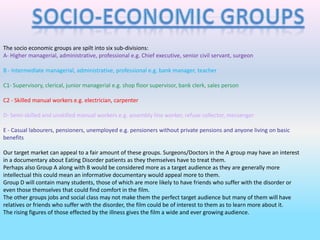Audience
This document discusses potential target audiences for a documentary about eating disorders. It analyzes the socio-economic groups and finds that higher income groups A and B may have more interest due to their intellectual nature. Group D contains many students who could relate through friends affected by disorders. While other groups may not be a perfect target, many will know someone impacted. The document then examines demographics like focusing on teenagers who can better relate, while including information on male disorders. Geographic markets with high disorder rates like Iceland and America are identified. Psychographic factors like attitudes towards mental health across generations are evaluated. Research methods proposed involve interviews with those affected and medical professionals, as well as public surveys.

Recommended
Recommended
More Related Content
Viewers also liked
Viewers also liked (9)
Similar to Audience
Similar to Audience (17)
More from JoeRobert
More from JoeRobert (20)
Audience
- 1. Socio-Economic Groups The socio economic groups are spilt into six sub-divisions: A- Higher managerial, administrative, professional e.g. Chief executive, senior civil servant, surgeon B - Intermediate managerial, administrative, professional e.g. bank manager, teacher C1- Supervisory, clerical, junior managerial e.g. shop floor supervisor, bank clerk, sales person C2 - Skilled manual workers e.g. electrician, carpenter D- Semi-skilled and unskilled manual workers e.g. assembly line worker, refuse collector, messenger E - Casual labourers, pensioners, unemployed e.g. pensioners without private pensions and anyone living on basic benefits Our target market can appeal to a fair amount of these groups. Surgeons/Doctors in the A group may have an interest in a documentary about Eating Disorder patients as they themselves have to treat them. Perhaps also Group A along with B would be considered more as a target audience as they are generally more intellectual this could mean an informative documentary would appeal more to them. Group D will contain many students, those of which are more likely to have friends who suffer with the disorder or even those themselves that could find comfort in the film. The other groups jobs and social class may not make them the perfect target audience but many of them will have relatives or friends who suffer with the disorder, the film could be of interest to them as to learn more about it. The rising figures of those effected by the illness gives the film a wide and ever growing audience.
- 2. Classification of audiences Demographics: Age – We feel our film would be best suited to a younger audience. Eating disorders are most common in teenagers and we feel this age range will be able to relate to the film more so than an older generation, too young an audience may be influenced negatively by the film. Gender – statistics show 6/7 eating disorders are diagnosed to women, it therefore seems logical that the audience we are looking to attract would be predominantly female. We will however include part on male eating disorders, although only 1/7 of patients are male there is still a niche market there to attract. Geographic: Despite America having the highest death toll a year from eating disorders, standing at 218 deaths per year, Iceland on average is affected the most by the disorder with nearly 1 in every 250,000 people a year dying from eating disorders, America come in at around just under 1 in every million dying from the illness per year. These countries could provide a bigger audience for the film as they may be more aware of the illness and are affected more so, it could serve as educational to help understand the illness better. Psychographic: The attitudes and values of our audience will highly affect what they think of the film. Many people have a negative outlook on mental health and view it as an excuse. Older generations are more prone to this mind-set and do not understand the complexity of mental disorders, some merely jus put it down to being a phase. Other potential audiences could be those who have an interest in mental health/ eating disorders. Many of the relatives and friends of those affected by the illness seek knowledge and understanding of the issue, the film could have a wide appeal to them.
- 3. Research Methods Myself and Kathleen know of people who have been affected by eating disorders and can ask them for information on the illness and their views on the topic. we also have access to various psychiatrists and doctors who treat eating disorder patients and can gather information on many subjects; how they start, the effects, how long they can last etc. Using questionnaires we can get feedback on the publics general knowledge of eating disorders and what their understanding is of it. Our actual film will include on the street interviews with the general public, and organised interviews with those affected.